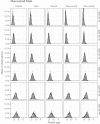Evaluating distributional regression strategies for modelling self-reported sexual age-mixing
- PMID: 34165078
- PMCID: PMC8263061
- DOI: 10.7554/eLife.68318
Evaluating distributional regression strategies for modelling self-reported sexual age-mixing
Abstract
The age dynamics of sexual partnership formation determine patterns of sexually transmitted disease transmission and have long been a focus of researchers studying human immunodeficiency virus. Data on self-reported sexual partner age distributions are available from a variety of sources. We sought to explore statistical models that accurately predict the distribution of sexual partner ages over age and sex. We identified which probability distributions and outcome specifications best captured variation in partner age and quantified the benefits of modelling these data using distributional regression. We found that distributional regression with a sinh-arcsinh distribution replicated observed partner age distributions most accurately across three geographically diverse data sets. This framework can be extended with well-known hierarchical modelling tools and can help improve estimates of sexual age-mixing dynamics.
Keywords: age mixing; bayesian statistics; distributional regression; epidemiology; global health; none; sexual behaviour; sinh-arcsinh distribution.
© 2021, Wolock et al.
Conflict of interest statement
TW, SF, KR, TD, SG, JE No competing interests declared
Figures


















References
-
- Arias Garcia S, Chen J, Calleja JG, Sabin K, Ogbuanu C, Lowrance D, Zhao J. Availability and Quality of Surveillance and Survey Data on HIV Prevalence Among Sex Workers, Men Who Have Sex With Men, People Who Inject Drugs, and Transgender Women in Low- and Middle-Income Countries: Review of Available Data (2001-2017) JMIR Public Health and Surveillance. 2020;6:e21688. doi: 10.2196/21688. - DOI - PMC - PubMed
-
- Bürkner P-C. Advanced bayesian multilevel modeling with the R package brms. The R Journal. 2018;10:395–411. doi: 10.32614/RJ-2018-017. - DOI
Publication types
MeSH terms
Grants and funding
LinkOut - more resources
Full Text Sources

